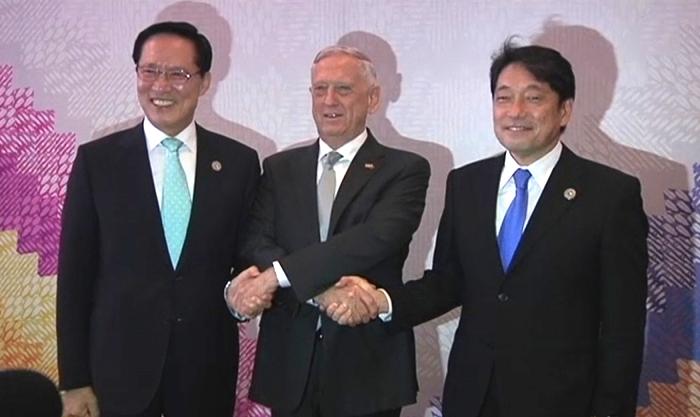SEOUL–U.S. Defense Secretary Jim Mattis flew into Seoul on Friday for annual defense talks as tensions with North Korea climb ahead of a visit to the region next month by President Donald Trump.
Mattis has emphasized diplomatic efforts to find a peaceful solution to the crisis during his week-long trip to Asia, even as North Korea’s weapons tests and bellicose verbal exchanges between Pyongyang and Washington stoke fears of an armed confrontation.
“I carried the message that the more we do together today the greater the chance for enduring peace in the future,” Mattis said earlier this week, looking back at three days of meetings with Asian defense chiefs in the Philippines.
“That’s really what it was all about – to keep the (North Korea) effort firmly in the diplomatic lane for resolution.”
Even before landing in Seoul, Mattis held a meeting in the Philippines on Monday with his South Korea and Japanese counterparts, where they agreed to keep bolstering intelligence sharing about North Korea and enhance exercises.
“Now we got to do the ‘roll up our sleeves’ (work) and do the pragmatic planning and coordination,” he told reporters.
Japanese Defence Minister Itsunori Onodera warned the threat from North Korea has grown to a “critical and imminent level”.
CIA chief Mike Pompeo said last week North Korea could be only months away from developing the ability to hit the United States with nuclear weapons, a scenario Trump has vowed to prevent.
U.S. intelligence experts say Pyongyang believes it needs the weapons to ensure its survival and have been skeptical about diplomatic efforts, focusing on sanctions, to get Pyongyang to denuclearize.
The United States on Thursday imposed sanctions on seven North Korean individuals and three entities for “flagrant” human rights abuses, including killings, torture, forced labor and the hunting down of asylum seekers abroad.
Nobody “Rushing For War”
The visit comes just before Trump’s departs on Nov. 3 to Japan, South Korea, China, Vietnam and the Philippines, a trip which is expected to be dominated by the nuclear and ballistic missile threat posed by North Korea.Trump, in a speech last month at the United Nations, threatened to destroy North Korea if necessary to defend itself and allies. Kim has blasted Trump as “mentally deranged.”
Despite the rhetoric, White House officials say Trump is looking for a peaceful resolution of the standoff. But all options, including military ones, are on the table.
Mattis, for his part, dismissed the idea that U.S. allies were confused about the U.S. approach, noting U.S. Secretary of State Rex Tillerson’s recent trip to Beijing to get China to do more to pressure Pyongyang.
China is North Korea’s biggest trading partner.
“Do we have military options in defense for attack, if our allies are attacked? Of course we do. But everyone is out for a peaceful resolution,” Mattis told reporters traveling with him earlier this week.
“No one’s rushing for war.”





